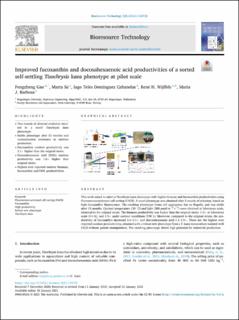| dc.contributor.author | Gao, Fengzheng | |
| dc.contributor.author | Sá, Marta | |
| dc.contributor.author | Cabanelas, Iago Teles Dominguez | |
| dc.contributor.author | Wijffels, Rene Hubertus | |
| dc.contributor.author | Barbosa, Maria J. | |
| dc.date.accessioned | 2022-07-14T14:19:01Z | |
| dc.date.available | 2022-07-14T14:19:01Z | |
| dc.date.created | 2021-04-09T17:51:18Z | |
| dc.date.issued | 2021 | |
| dc.identifier.citation | Gao, F., Sá, M., Cabanelas, I. T. D., Wijffels, R. H. & Barbosa, M. J. (2021). Improved fucoxanthin and docosahexaenoic acid productivities of a sorted self-settling Tisochrysis lutea phenotype at pilot scale, Bioresource Technology, 325, 1-10: 124725. doi: | en_US |
| dc.identifier.issn | 1873-2976 | |
| dc.identifier.uri | https://hdl.handle.net/11250/3005447 | |
| dc.description.abstract | This work aimed to select a Tisochrysis lutea phenotype with higher biomass and fucoxanthin productivities using fluorescence-activated cell sorting (FACS). A novel phenotype was obtained after 2 rounds of selection, based on high-fucoxanthin fluorescence. The resulting phenotype forms cell aggregates, has no flagella, and was stable after 15 months. Optimal temperature (30 °C) and light (300 µmol m−2 s−1) were obtained at laboratory scale, identical to the original strain. The biomass productivity was higher than the original strain: 1.9× at laboratory scale (0.4 L), and 4.5× under outdoor conditions (190 L). Moreover, compared to the original strain, the productivity of fucoxanthin increased 1.6–3.1× and docosahexaenoic acid 1.5–1.9×. These are the highest ever reported outdoor productivities, obtained with a robust new phenotype from a T. lutea monoculture isolated with FACS without genetic manipulation. The resulting phenotype shows high potential for industrial production. | en_US |
| dc.language.iso | eng | en_US |
| dc.publisher | Elsevier | en_US |
| dc.rights | Navngivelse 4.0 Internasjonal | * |
| dc.rights.uri | http://creativecommons.org/licenses/by/4.0/deed.no | * |
| dc.title | Improved fucoxanthin and docosahexaenoic acid productivities of a sorted self-settling Tisochrysis lutea phenotype at pilot scale | en_US |
| dc.type | Peer reviewed | en_US |
| dc.type | Journal article | en_US |
| dc.description.version | publishedVersion | en_US |
| dc.rights.holder | © 2021 The Author(s) | en_US |
| dc.subject.nsi | VDP::Matematikk og Naturvitenskap: 400::Basale biofag: 470::Molekylærbiologi: 473 | en_US |
| dc.subject.nsi | VDP::Landbruks- og Fiskerifag: 900::Fiskerifag: 920::Ressursbiologi: 921 | en_US |
| dc.subject.nsi | VDP::Matematikk og Naturvitenskap: 400::Basale biofag: 470::Biofysikk: 477 | en_US |
| dc.source.pagenumber | 1-10 | en_US |
| dc.source.volume | 325 | en_US |
| dc.source.journal | Bioresource Technology | en_US |
| dc.identifier.doi | 10.1016/j.biortech.2021.124725 | |
| dc.identifier.cristin | 1903286 | |
| dc.relation.project | EC/H2020/745754 | en_US |
| dc.source.articlenumber | 124725 | en_US |

